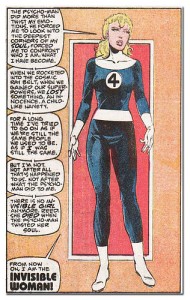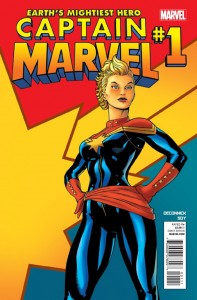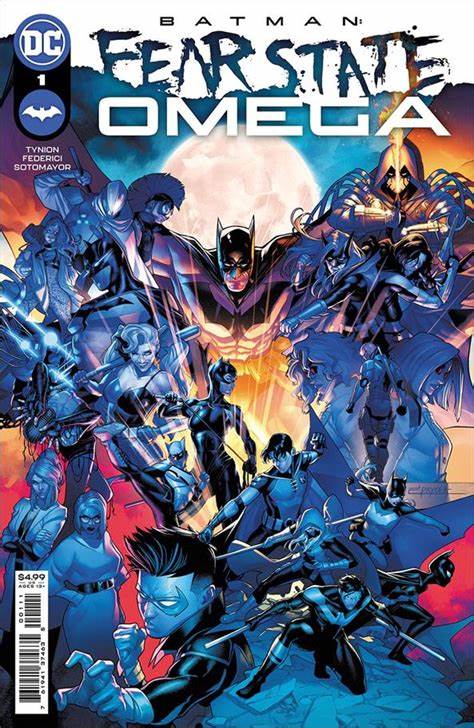Taking the Long Way: The Super-Heroine’s Struggle for Respect
An essay by Bob Reyer
With 8 March being International Women’s Day, I thought I’d re-post this piece that was originally written for our collaboration with Dr. Maria Norris and the London School of Economics. Some of the issues that I cover here have seen a bit of forward progress in the years since I wrote this, but not nearly enough to my way of thinking, so much of what follows is still quite relevant!
Click here for the introduction to Comics, Human Rights and Representation Week.
As in the real world struggle for women’s rights, many of the steps toward more proper representation for female heroes have been met by resistance, with some of the latest battles taking on a “Boy’s Club/No Girls Allowed” caste that doesn’t take into consideration the historical data which shows that up through the Silver Age, female readers made up around half of the marketplace. “Women don’t buy comics” Trina Robbins was told when pitching a female-led book to DC; she replied “Not when they’re insulting to us, we don’t!” From their beginnings, super-heroines have had the added burden of representing the changing face of womanhood, often while their stories were crafted by unsympathetic pens.
Women have always been a part of the comic book industry; in fact, barely six months after the June 1938 debut of Superman in Action Comics #1, “Sheena, Queen of the Jungle” appeared in Jumbo Comics #1 from Fiction House, a publisher who had previously specialized in pulp adventure magazines. (“Sheena…” was previewed in a 1937 British comics magazine called Wags #1, so in the U.K., she arrives before Superman!) They would soon add titles such as Jungle Comics, Wings Comics, and Planet Comics, the latter being the home for many series featuring distaff heroes throughout the early-to-mid Forties such as “Gale Allen and her Girl Squadron”, “Mysta of the Moon”, “Futura”, and “Amazona, the Mighty Woman”, whose one and only appearance in May 1940’s Planet Comics #3 pre-dates the debut of that other fabulous Amazon. These stories featured women of intelligence, courage, and determination, much closer to Flash Gordon in attitude than Dale Arden. However, reflecting their pulp beginnings, many Fiction House covers were illustrated in what is known as the “good girl” pin-up style, which although far more respectful of their subjects than some of today’s more problematic images from companies like Zenescope, was still a disconnect from the work within, much of it by pioneer female artists such as Lily Renee, Fran Hopper, and Ruth Atkinson, or written by the prolific Ruth Roche.
Superman!) They would soon add titles such as Jungle Comics, Wings Comics, and Planet Comics, the latter being the home for many series featuring distaff heroes throughout the early-to-mid Forties such as “Gale Allen and her Girl Squadron”, “Mysta of the Moon”, “Futura”, and “Amazona, the Mighty Woman”, whose one and only appearance in May 1940’s Planet Comics #3 pre-dates the debut of that other fabulous Amazon. These stories featured women of intelligence, courage, and determination, much closer to Flash Gordon in attitude than Dale Arden. However, reflecting their pulp beginnings, many Fiction House covers were illustrated in what is known as the “good girl” pin-up style, which although far more respectful of their subjects than some of today’s more problematic images from companies like Zenescope, was still a disconnect from the work within, much of it by pioneer female artists such as Lily Renee, Fran Hopper, and Ruth Atkinson, or written by the prolific Ruth Roche.
Two series would debut in 1941 that were more consistent in how their leads were presented. April of that year would see the initial publication of Miss Fury, the first major costumed heroine, in the pages of newspapers around America. (These strips would be collected and printed as comic books by Timely, and sell over a million copies an issue!) Socialite Marla Drake would don a ceremonial panther-skin catsuit (long before Catwoman—or the Black Panther) and take on injustice, Nazi spies and all manner of adventures. Miss Fury’s creator, the stunning Tarpe Mills, was one of a handful of female artist/writers of the time, and imbued Miss Fury with a sense of purpose and individuality that now seems prescient of the yet-to-come Women’s Movement. Comics her-storian Ms. Trina Robbins has selected a series of strips and written introductory historical essays for a marvelous two-volume hardcover collection published by IDW that showcases this trail-blazing creation, whose most recent incarnation, alas, is in a series from Dynamite that is sadly off-model in attempting to be “hard-boiled”, and comes off only as a poor and profane imitation.
The most important super-heroine of all would first see print in the Fall 1941 issue #8 of All-Star Comics, as Wonder Woman would make her debut! As others on this site will be telling the Amazing Amazon’s story, I’ll stick to the bare bones by saying that her creators, psychologist Dr. William Moulton Marston and his equally-educated wife Elizabeth, were looking for a way to combat what he described as the “blood-curdling masculinity” of the male super-heroes, as well as promote to both girls and boys his ideas regarding the coming “New Woman”, whose compassion-leavened strength he believed would bring about a better world for all. Wonder Woman was an instant hit, soon top-lining Sensation Comics and her own title, with both selling millions of copies, but neither the Amazon Princess nor her other heroic sisters such as the original Black Cat and Miss America would survive unscathed the dual blows of the changes to American society after World War II and the following anti-comic-book hysteria of the early-Fifties.
As servicemen returned to the jobs that were being held by women during the war, a creeping trend toward feminine domesticity began to take hold of the American zeitgeist, and in comics that was reflected in the down-playing of super-heroines’ self-reliance and positive messages (as in the case of Wonder Woman after the death of Dr. Marston in 1947), as well as through their shrinking numbers. These factors would be amped-up even further by the crusade against comics by Dr. Fredric Wertham, whose 1954 book “Seduction of the Innocent” created a firestorm that led to Congressional investigations, the self-censoring Comics Code Authority, and a decimated comic book industry. Even Wonder Woman (virtually the only super-heroine remaining) was left a shell of the figure she was, now more concerned with romantic encounters with Steve Trevor than changing the hearts and minds in “Man’s World”.
These factors would be amped-up even further by the crusade against comics by Dr. Fredric Wertham, whose 1954 book “Seduction of the Innocent” created a firestorm that led to Congressional investigations, the self-censoring Comics Code Authority, and a decimated comic book industry. Even Wonder Woman (virtually the only super-heroine remaining) was left a shell of the figure she was, now more concerned with romantic encounters with Steve Trevor than changing the hearts and minds in “Man’s World”.
Throughout the Fifties, whatever new super-heroines appeared were generally spin-offs of male characters such as Supergirl, and their stories seldom displayed any of the take-charge attitudes of their WW II counterparts; instead, we’d get to see Batwoman fight crime with utility belt gadgets such as expanding hair-nets and a compact that could generate a smoke-screen. Non-costumed characters fared little better, as Lois Lane was reduced to “Superman’s Girlfriend”, constantly engaged in schemes to either learn whether Clark was Superman, or trick the Man of Steel into marriage. A change was on the horizon, although the first steps were certainly hard to see as ground-breaking.
1961 saw the publication of Fantastic Four #1 by Stan Lee and Jack Kirby, who brought something new to the world of super-heroics with their multi-faceted characters, but early on, despite their stated intentions of her being an equal member of the team, the Invisible Girl would far too often be placed in the guise of the “damsel in distress”. However, as the series continued her role would expand, taking on more prominence during adventures, as well as becoming comics’ first super-heroine wife and mother. Through the good works of writers such as Roy Thomas, Gerry Conway, and particularly writer/artist John Byrne (who re-named her the Invisible Woman in FF #284), Susan Storm Richards still inhabits a fictional biography as rich as any in the comics medium, and due to the era in which she was created, and the sheer length of publication of the Fantastic Four, her character would experience all the peaks and valleys of the treatment of female heroes, from the burgeoning Women’s Rights movement of the 60s & 70s, through to the “Bad Girl” era of the 90s.
the Invisible Girl would far too often be placed in the guise of the “damsel in distress”. However, as the series continued her role would expand, taking on more prominence during adventures, as well as becoming comics’ first super-heroine wife and mother. Through the good works of writers such as Roy Thomas, Gerry Conway, and particularly writer/artist John Byrne (who re-named her the Invisible Woman in FF #284), Susan Storm Richards still inhabits a fictional biography as rich as any in the comics medium, and due to the era in which she was created, and the sheer length of publication of the Fantastic Four, her character would experience all the peaks and valleys of the treatment of female heroes, from the burgeoning Women’s Rights movement of the 60s & 70s, through to the “Bad Girl” era of the 90s.
As comics moved through the Sixties and into the Seventies, DC debuted Barbara Gordon as Batgirl, Zatanna, and Power Girl, while Marvel increased the roles of their female characters such as Susan Richards, Janet Van Dyne (The Wasp), and Natasha Romanov, as well as introducing their own “Amazon” in the form of the Norse warrior woman, The Valkyrie. Oddly, during this period of increasing clamor for Women’s Rights, Wonder Woman had been de-powered by DC in a well-intentioned, but ultimately mis-guided attempt by Denny O’Neil and Mike Sekowsky to make her more relevant to the modern, “liberated woman” by stripping her of her Amazonian gifts and heritage. This struck more readers as insulting than uplifting, and after much hue-and-cry from fans (and a plea from Ms. Magazine co-founder Gloria Steinem), DC restored the status quo.
What that move couldn’t do was reverse the trend that saw women beginning to drift away from super-hero comics as the books were increasingly male-centric power fantasies. Both of The Big Two attempted to stem the tide to little effect, with DC re-emphasizing gothic horror and romance comics, and Marvel launching female-led books by female creators in Night Nurse, The Cat, and Shanna, the She-Devil. The outlier in this through into the late-Eighties would be the X-Men as written by Chris Claremont, whose diverse group of finely-crafted super-heroines would hold onto a disproportionate-to-the-time percentage of female readers by providing them with characters that were both aspirational and relatable, a combination that would soon seem to many as passé.
The flickering candle of the noble super-heroine would be nearly extinguished during the Nineties in the era defined by the first incarnation of Image Comics and their house art style which would serve as the model for the hyper-sexualized heroines of the “Bad Girl” movement. Impossibly nubile, scantily clad, and ludicrously posed in the broke-back/Escher-girl fashion, characters such as  Witchblade, Fathom, Glory, and Lady Death would not only run violently rough-shod through their own books,
Witchblade, Fathom, Glory, and Lady Death would not only run violently rough-shod through their own books,  but appear in “Lingerie Special” issues that codified their reversal in roles from subjects with agency to objectified fantasy figures. This mind-set would infect the entire industry, with Marvel aping the art style of their former employees and publishing “Swimsuit Editions”, and with formerly up-standing characters from each company such as Wonder Woman and Susan Richards togged out as if for the cover of a fetish magazine, adorned in thongs, midriff-baring tops, thigh boots, and the ubiquitous-for-the-time straps, pouches and weaponry.
but appear in “Lingerie Special” issues that codified their reversal in roles from subjects with agency to objectified fantasy figures. This mind-set would infect the entire industry, with Marvel aping the art style of their former employees and publishing “Swimsuit Editions”, and with formerly up-standing characters from each company such as Wonder Woman and Susan Richards togged out as if for the cover of a fetish magazine, adorned in thongs, midriff-baring tops, thigh boots, and the ubiquitous-for-the-time straps, pouches and weaponry.
It is not coincidental that portraying super-heroines in this objectifying fashion would lead to excesses in story-telling as well, and this “Dark Age” would feature stories that would defile the feminine heroic model in such a way that it spurred the 1999 creation by soon-to-be comics writer Gail Simone of the “Women in Refrigerators” website. Named after an incident in Green Lantern #54 where-in the hero’s girl-friend is murdered and stuffed into his refrigerator, the site would list all the indignities piled on to female lead and supporting characters which reduced them to mere sexualized and disposable plot devices, another factor in the recession of women as comics readers at the time. As Ms. Simone pointed out “If you demolish most of the characters girls like, then girls won’t like comics. That’s it!” Ms. Simone would, of course, go on to a long run as the writer of the DC title Birds of Prey, the most important female-lead book of the period, and continue on into today with the creation of The Movement, which features a multi-racial, -abled, and –gender-identified cast, and also created Alysia Yeoh, Barbara Gordon’s best friend and room-mate, and a beloved trans character.
As in the real world, the comic book Dark Ages has been followed by a Renaissance, and I believe that in this case its origin can be traced to Captain Marvel as penned by Kelly Sue DeConnick.  Carol Danvers had taken on the role of Ms. Marvel in that book’s first issue in 1977 to reflect the changing roles of women, but as the years passed she had come on some hard times at the hands of various creative teams, being twice de-powered, turned into an angry drunkard, and topping it all, sexually assaulted and sent off with her abuser by her team-mates in The Avengers in their issue #200 in 1980. (This would be addressed quite brilliantly by Chris Claremont in the next year’s Avengers Annual #10.)
Carol Danvers had taken on the role of Ms. Marvel in that book’s first issue in 1977 to reflect the changing roles of women, but as the years passed she had come on some hard times at the hands of various creative teams, being twice de-powered, turned into an angry drunkard, and topping it all, sexually assaulted and sent off with her abuser by her team-mates in The Avengers in their issue #200 in 1980. (This would be addressed quite brilliantly by Chris Claremont in the next year’s Avengers Annual #10.)
The 2012 re-launch as Captain Marvel of this previously “multi-fridged” heroine clearly resonated with both old and new readers, who found in Carol Danvers a super-human character that will show us her human frailties, but who in her quest to overcome them, never fails to demonstrate what true heroism is about. The positive energy generated by the Captain Marvel series flooded through fandom into Marvel’s offices, leading to the first female legacy hero, the Kamala Khan Ms. Marvel as created by editor Sana Amanat, writer G. Willow Wilson, and artists Adrian Alphona and Jamie McKelvie. An uber-fan of Captain Marvel, the sixteen-year-old Kamala is presented as a genuine teenager, albeit one with a special set of problems, not the least of which are her rather-strict Pakistani-American parents, who are concerned about how their daughter is managing to juggle the responsibilities of school, friends, and family whilst honoring their Muslim faith, unaware of her side-job as protector of Jersey City.
Thankfully, and at long last, Marvel, DC, Image, and the other publishers started to finally realize how poorly they were serving a huge and untapped readership, and would begin to address this through the release of titles that were aimed at a broader market than the stereotypical “25-to-45 white male”, with indie series as diverse in their presentation as Saga, Princeless, Lumberjanes, Velvet, and Rat Queens, and even the majors trying for more inclusionary fare with titles such as Gotham Academy, Storm, She-Hulk, Black Widow, and the re-launched Batgirl.
The broad range of topics, themes, and tone in these books opens up the world of comics to fans of many genres across the literary and filmic spectra, and could signal the start of another Golden Age for comic books and their fans, both as to the variety and quality of the books, and to the positive nature of female representation. We’ve hopefully returned to the equilibrium of the medium’s beginnings, and we’ll see more respectful, balanced and diverse presentations of female characters that will more reflect the world at large, and once again super-heroines will be figures that everyone can look up to, no matter the particulars of the reader.
SOURCES AND FURTHER READING
Stan Lee—“The Origins of Marvel Comics” (Simon & Schuster/1974)
Jill Lepore—“The Secret History of Wonder Woman” (Alfred A. Knopf/2014)
Mike Madrid—“Divas, Dames & Daredevils” (Exterminating Angel Press/2013)
“The Supergirls” (Exterminating Angel Press/2009)
“Vixens, Vamps & Vipers” (Exterminating Angel Press/2014)
Trina Robbins—“The Great Women Superheroes” (Kitchen Sink Press/1996)
“Pretty in Ink” (Fantagraphics/2013)
Jim Steranko—“The History of Comics Volume 1” (Supergraphics/1970)
(A quick digression; some years back I presented a version of this essay at the Connetquot Public Library, so if you feel like subjecting yourself to that, you can find it here. )














